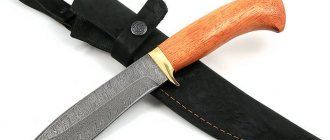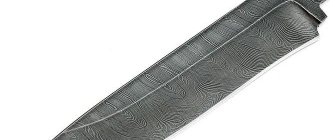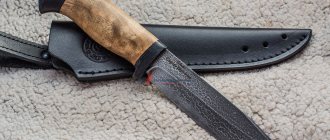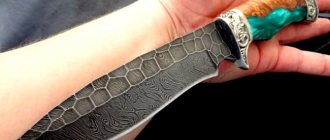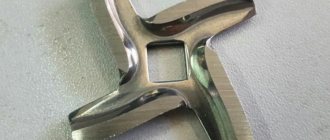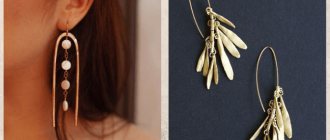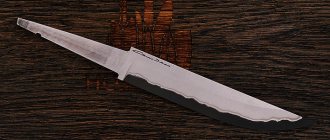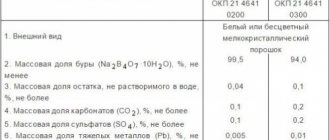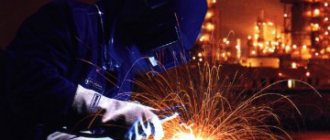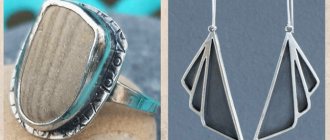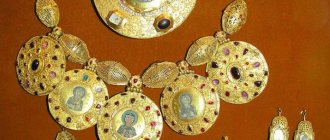Characteristics
Many people wonder what Damascus steel is for knives and why it is so popular. Its distinctive feature lies in the manufacturing method - alternating layers. The production process uses one layer with a high carbon content and a second layer with a low carbon content. A high level of carbon gives the product sharpness, while a low level gives it strength. Proper adherence to proportions and sequence of stages makes Damascus cutting objects incredibly sharp, strong and durable. Don't forget about the signature Damascus steel pattern on the knife.
The hardness of the product is determined according to the Rockwell scale. On the blade itself you can see the abbreviation HRC. The higher the number, the stronger and more durable the metal on the product. For example, the hardness of Chinese blades is 40 HRC, and that of samurai blades is 65 HRC. The indicator of high-quality Damascus steel will be at the level of 60-65 HRC.
Care of the scabbard
Knife care should not be one-sided. After cleaning the blade and lubricating the handle, you need to take care of the sheath. The main thing to understand here is that the sheath is a means of transporting a knife, and not a place for storing it. Tannins in the leather negatively affect the steel of the blade, and a wet and dirty knife left in the sheath for a long time can cause swelling and loss of elasticity of the material.
The outer surfaces of the sheath must be regularly cleaned of contaminants and treated with automotive leather conditioner. It is important not to forget to remove lint, grains of sand and other small debris from inside the sheath that may scratch the blade.
Leather easily absorbs stubborn pollutants such as rust. Therefore, if oxide has formed on the knife, you should not allow it to get on the surface of the sheath. It is also important to promptly renew torn seam threads and replace failed rivets.
Kinds
There are 3 main types of Damascus: layered, mosaic and torsion.
The forging process allows the production of metal with a multilayer structure with different compositions. The larger the pattern on the blade, the fewer layers were used during forging. The strength of steel will depend precisely on the number of layers: more layers, higher strength. However, a complex pattern in the form of zigzags or waves will only worsen the blade. A tool with thin and straight lines is a higher quality product with a long service life. To understand how knives are made from Damascus steel, you need to consider its types.
Layered Damascus
The layered type is the most common and easiest to manufacture. This type mainly includes knives. To create them, from 40 to 120 layers of steel are used. The number of layers directly affects the pattern of the blade; in the alloy they are located parallel to the product. This is how the pattern is obtained from equidistant straight lines. The famous Japanese katanas, with their straight pattern at the blade, are also classified as a layered type of Damascus steel.
Mosaic Damascus
The pattern on the mosaic blade is formed on the basis of various types of metal. The manufacturing process uses a press to ensure uniform processing. The patterns consist of diamond profiles that fit tightly together for better welding. After welding, the steel package is cut into small 30 mm plates with a mosaic pattern. These plates are then used to make blades with a special mosaic pattern.
The main “disadvantages” of mosaic damascus are low strength and low cutting properties.
Torsion Damascus
The peculiarity of the torsion bar is the twisted pattern on the knife, which is obtained thanks to rectangular rods. They are heated and then pulled into a bar, twisting around the axis of a steel package. The output is a pattern with helical lines that are inclined around the axis of the product. Torsion Damascus is the most difficult type to manufacture, since during the forging process the steel rods can be twisted, causing them to deform and burst.
You need to make a choice on this or that type of Damascus knife, taking into account many factors, but this is a matter of taste.
Differences between damask steel and Damascus steel
What is damask steel and how do different types of steel generally differ? Patterned metals were called differently at different times and by different peoples.
Various names for this metal were used:
- wootz;
- damask steel;
- Damascus steel;
- multi-day iron.
Let's consider two types - damask steel and Damascus steel.
The name damask steel has an ancient origin and comes from the Indo-Iranian word “pulad”, which means (refined iron). Hunting knives made of damask steel are distinguished by good cutting properties and excellent strength. And blades made from damask steel are quite expensive, and the choice is not very large.
Damask steel is a very durable alloy with a high coefficient of inflexibility and sharpness retention. This is a collective term that does not have a fixed manufacturing technology or appearance.
A hunting knife made of damask steel has various types of patterns on the blade, and it is superior to hunting knives made of Damascus steel in all respects:
- strength;
- no corrosion.
Bulat is steel that has been melted and cooled in a crucible in a special way, and its production is more expensive than Damascus.
Another name for damask comes from the word damask (wavy). Damascus steel is inferior to damask steel in certain indicators, but takes precedence with its variety of blades and relative cheapness.
It is obtained as a result of a complex technological process performed by hand. According to technology, there are always more hard steels than soft ones. The steel obtained in this way has about 400 layers, which gives it special strength, excellent cutting ability and unique beauty. Unique - in the literal sense of the word, because the pattern never repeats, just like people's fingerprints. Damascus steel is a separate grade of damask steel, differing from it in the beauty of the blade and its strength.
Damascus steel is prepared from plates through a forge welding process.
Damascus and damask steel mainly differ from each other in manufacturing technology and therefore they differ in appearance and physical properties.
Processing methods and technologies for the production of steel knives
Processing of refined steel
A monolithic block is required for processing. The steel is cleaned of impurities and slag, and carbon is evenly distributed in the workpiece. Hardening produces high-quality knives. The method was popular until the 18th century.
Welding method
Metals with different carbon contents are fused into one whole. The result is flexible and durable blades that absorb the advantages of both types of iron.
Bulat
Divided into two types:
– crucible damask steel (the metal is boiled in a crucible for a long time, then the alloy is cooled and the blade is forged);
– cast damask steel (blades are produced through a long-term melting process of metals with high and low carbon content; usually alloying elements are added to the mixture to improve the mechanical properties of the product).
The Damascus knife is rusting.
moved from Knife through the eyes of the owner
Please tell me! The RK began to become covered with rust, I corrected it on the stone and removed the rust. I smeared it with olive oil, it still shows through. Can etch. Just what?. Who knows, please tell me, the knife is expensive. it's a pity
And after etching the paint will rust, because it is sharpened and the coating is peeled off. Advice: wipe dry after use. Over time, it may darken, the corrosion will decrease, but this does not cancel wiping. I wouldn't cut food like that.
My pleasure
